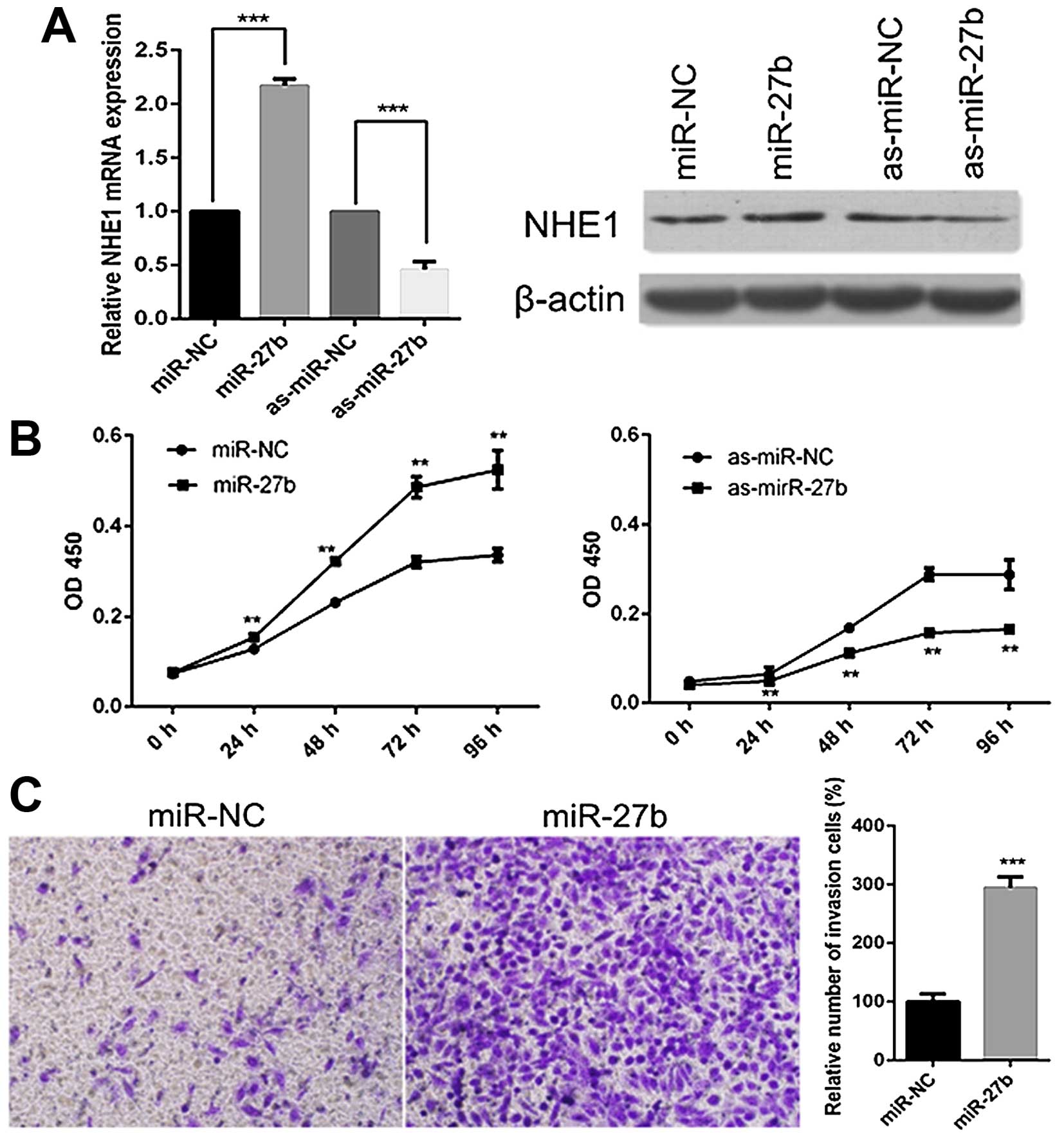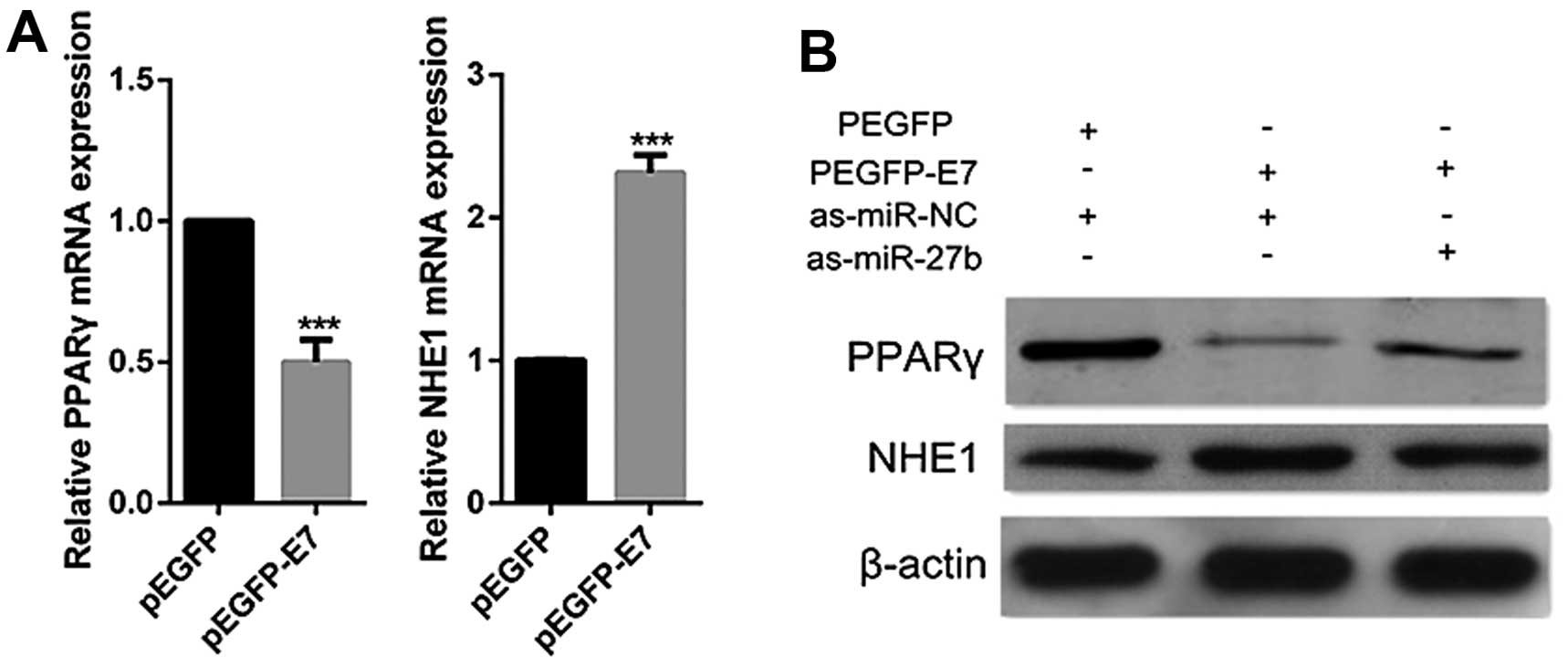|
1
|
Comprehensive Cervical Cancer Control. A
Guide to Essential Practice. World Health Organization; 2nd
edition. Geneva: 2014
|
|
2
|
Walboomers JM, Jacobs MV, Manos MM, Bosch
FX, Kummer JA, Shah KV, Snijders PJ, Peto J, Meijer CJ and Muñoz N:
Human papillomavirus is a necessary cause of invasive cervical
cancer worldwide. J Pathol. 189:12–19. 1999. View Article : Google Scholar : PubMed/NCBI
|
|
3
|
Tommasino M, Accardi R, Caldeira S, Dong
W, Malanchi I, Smet A and Zehbe I: The role of TP53 in cervical
carcinogenesis. Hum Mutat. 21:307–312. 2003. View Article : Google Scholar : PubMed/NCBI
|
|
4
|
Hwang SG, Lee D, Kim J, Seo T and Choe J:
Human papillomavirus type 16 E7 binds to E2F1 and activates
E2F1-driven transcription in a retinoblastoma protein-independent
manner. J Biol Chem. 277:2923–2930. 2002. View Article : Google Scholar
|
|
5
|
Bartel DP: MicroRNAs: Genomics,
biogenesis, mechanism, and function. Cell. 116:281–297. 2004.
View Article : Google Scholar : PubMed/NCBI
|
|
6
|
Calin GA and Croce CM: MicroRNA signatures
in human cancers. Nat Rev Cancer. 6:857–866. 2006. View Article : Google Scholar : PubMed/NCBI
|
|
7
|
Di Leva G and Croce CM: Roles of small
RNAs in tumor formation. Trends Mol Med. 16:257–267. 2010.
View Article : Google Scholar : PubMed/NCBI
|
|
8
|
Esquela-Kerscher A and Slack FJ: Oncomirs
- microRNAs with a role in cancer. Nat Rev Cancer. 6:259–269. 2006.
View Article : Google Scholar : PubMed/NCBI
|
|
9
|
Zhang B, Pan X, Cobb GP and Anderson TA:
microRNAs as oncogenes and tumor suppressors. Dev Biol. 302:1–12.
2007. View Article : Google Scholar
|
|
10
|
Lin Z and Flemington EK: miRNAs in the
pathogenesis of oncogenic human viruses. Cancer Lett. 305:186–199.
2011. View Article : Google Scholar :
|
|
11
|
Zheng ZM and Wang X: Regulation of
cellular miRNA expression by human papillomaviruses. Biochim
Biophys Acta. 1809:668–677. 2011. View Article : Google Scholar : PubMed/NCBI
|
|
12
|
Mangelsdorf DJ, Thummel C, Beato M,
Herrlich P, Schütz G, Umesono K, Blumberg B, Kastner P, Mark M,
Chambon P, et al: The nuclear receptor superfamily: The second
decade. Cell. 83:835–839. 1995. View Article : Google Scholar : PubMed/NCBI
|
|
13
|
Youssef J and Badr M: Peroxisome
proliferator-activated receptors and cancer: Challenges and
opportunities. Br J Pharmacol. 164:68–82. 2011. View Article : Google Scholar : PubMed/NCBI
|
|
14
|
Kim KY, Kim SS and Cheon HG: Differential
anti-proliferative actions of peroxisome proliferator-activated
receptor-gamma agonists in MCF-7 breast cancer cells. Biochem
Pharmacol. 72:530–540. 2006. View Article : Google Scholar : PubMed/NCBI
|
|
15
|
Sarraf P, Mueller E, Jones D, King FJ,
DeAngelo DJ, Partridge JB, Holden SA, Chen LB, Singer S, Fletcher
C, et al: Differentiation and reversal of malignant changes in
colon cancer through PPARgamma. Nat Med. 4:1046–1052. 1998.
View Article : Google Scholar : PubMed/NCBI
|
|
16
|
Tontonoz P, Singer S, Forman BM, Sarraf P,
Fletcher JA, Fletcher CD, Brun RP, Mueller E, Altiok S, Oppenheim
H, et al: Terminal differentiation of human liposarcoma cells
induced by ligands for peroxisome proliferator-activated receptor
gamma and the retinoid X receptor. Proc Natl Acad Sci USA.
94:237–241. 1997. View Article : Google Scholar : PubMed/NCBI
|
|
17
|
Cellai I, Benvenuti S, Luciani P, Galli A,
Ceni E, Simi L, Baglioni S, Muratori M, Ottanelli B, Serio M, et
al: Antineoplastic effects of rosiglitazone and PPARgamma
transactivation in neuroblastoma cells. Br J Cancer. 95:879–888.
2006. View Article : Google Scholar : PubMed/NCBI
|
|
18
|
Jung TI, Baek WK, Suh SI, Jang BC, Song
DK, Bae JH, Kwon KY, Bae JH, Cha SD, Bae I, et al: Down-regulation
of peroxisome proliferator-activated receptor gamma in human
cervical carcinoma. Gynecol Oncol. 97:365–373. 2005. View Article : Google Scholar : PubMed/NCBI
|
|
19
|
Kumar AP, Quake AL, Chang MK, Zhou T, Lim
KS, Singh R, Hewitt RE, Salto-Tellez M, Pervaiz S and Clément MV:
Repression of NHE1 expression by PPARgamma activation is a
potential new approach for specific inhibition of the growth of
tumor cells in vitro and in vivo. Cancer Res. 69:8636–8644. 2009.
View Article : Google Scholar : PubMed/NCBI
|
|
20
|
Reshkin SJ, Cardone RA and Harguindey S:
Na+-H+ exchanger, pH regulation and cancer.
Recent Pat Anticancer Drug Discov. 8:85–99. 2013. View Article : Google Scholar
|
|
21
|
Reshkin SJ, Bellizzi A, Caldeira S,
Albarani V, Malanchi I, Poignee M, Alunni-Fabbroni M, Casavola V
and Tommasino M: Na+/H+ exchanger-dependent
intracellular alkalinization is an early event in malignant
transformation and plays an essential role in the development of
subsequent transformation-associated phenotypes. FASEB J.
14:2185–2197. 2000. View Article : Google Scholar : PubMed/NCBI
|
|
22
|
Tang S, Tao M, McCoy JP Jr and Zheng ZM:
The E7 oncoprotein is translated from spliced E6*I transcripts in
high-risk human papillomavirus type 16- or type 18-positive
cervical cancer cell lines via translation reinitiation. J Virol.
80:4249–4263. 2006. View Article : Google Scholar : PubMed/NCBI
|
|
23
|
Livak KJ and Schmittgen TD: Analysis of
relative gene expression data using real-time quantitative PCR and
the 2(−Delta Delta C(T)) method. Methods. 25:402–408. 2001.
View Article : Google Scholar
|
|
24
|
Martinez I, Gardiner AS, Board KF, Monzon
FA, Edwards RP and Khan SA: Human papillomavirus type 16 reduces
the expression of microRNA-218 in cervical carcinoma cells.
Oncogene. 27:2575–2582. 2008. View Article : Google Scholar :
|
|
25
|
Karbiener M, Fischer C, Nowitsch S,
Opriessnig P, Papak C, Ailhaud G, Dani C, Amri EZ and Scheideler M:
microRNA miR-27b impairs human adipocyte differentiation and
targets PPARgamma. Biochem Biophys Res Commun. 390:247–251. 2009.
View Article : Google Scholar : PubMed/NCBI
|
|
26
|
Jennewein C, von Knethen A, Schmid T and
Brüne B: MicroRNA-27b contributes to lipopolysaccharide-mediated
peroxisome proliferator-activated receptor gamma (PPARgamma) mRNA
destabilization. J Biol Chem. 285:11846–11853. 2010. View Article : Google Scholar : PubMed/NCBI
|
|
27
|
Ghittoni R, Accardi R, Hasan U, Gheit T,
Sylla B and Tommasino M: The biological properties of E6 and E7
oncoproteins from human papillomaviruses. Virus Genes. 40:1–13.
2010. View Article : Google Scholar
|
|
28
|
Cardone RA, Busco G, Greco MR, Bellizzi A,
Accardi R, Cafarelli A, Monterisi S, Carratù P, Casavola V,
Paradiso A, et al: HPV16 E7-dependent transformation activates NHE1
through a PKA-RhoA-induced inhibition of p38alpha. PLoS One.
3:e35292008. View Article : Google Scholar : PubMed/NCBI
|
|
29
|
Myklebust MP, Bruland O, Fluge Ø,
Skarstein A, Balteskard L and Dahl O: MicroRNA-15b is induced with
E2F-controlled genes in HPV-related cancer. Br J Cancer.
105:1719–1725. 2011. View Article : Google Scholar : PubMed/NCBI
|
|
30
|
Melar-New M and Laimins LA: Human
papillomaviruses modulate expression of microRNA 203 upon
epithelial differentiation to control levels of p63 proteins. J
Virol. 84:5212–5221. 2010. View Article : Google Scholar : PubMed/NCBI
|
|
31
|
Kim SY, Kim AY, Lee HW, Son YH, Lee GY,
Lee JW, Lee YS and Kim JB: miR-27a is a negative regulator of
adipocyte differentiation via suppressing PPARgamma expression.
Biochem Biophys Res Commun. 392:323–328. 2010. View Article : Google Scholar : PubMed/NCBI
|
|
32
|
Ye J, Wu X, Wu D, Wu P, Ni C, Zhang Z,
Chen Z, Qiu F, Xu J and Huang J: miRNA-27b targets vascular
endothelial growth factor C to inhibit tumor progression and
angiogenesis in colorectal cancer. PLoS One. 8:e606872013.
View Article : Google Scholar : PubMed/NCBI
|
|
33
|
Wan L, Zhang L, Fan K and Wang J: MiR-27b
targets LIMK1 to inhibit growth and invasion of NSCLC cells. Mol
Cell Biochem. 390:85–91. 2014. View Article : Google Scholar : PubMed/NCBI
|
|
34
|
Wang Y, Rathinam R, Walch A and Alahari
SK: ST14 (suppression of tumorigenicity 14) gene is a target for
miR-27b, and the inhibitory effect of ST14 on cell growth is
independent of miR-27b regulation. J Biol Chem. 284:23094–23106.
2009. View Article : Google Scholar : PubMed/NCBI
|
|
35
|
Chen L, Li H, Han L, Zhang K, Wang G, Wang
Y, Liu Y, Zheng Y, Jiang T, Pu P, et al: Expression and function of
miR-27b in human glioma. Oncol Rep. 26:1617–1621. 2011.PubMed/NCBI
|
|
36
|
Grommes C, Landreth GE, Sastre M, Beck M,
Feinstein DL, Jacobs AH, Schlegel U and Heneka MT: Inhibition of in
vivo glioma growth and invasion by peroxisome
proliferator-activated receptor gamma agonist treatment. Mol
Pharmacol. 70:1524–1533. 2006. View Article : Google Scholar : PubMed/NCBI
|
|
37
|
Chearwae W and Bright JJ: PPARgamma
agonists inhibit growth and expansion of CD133+ brain
tumour stem cells. Br J Cancer. 99:2044–2053. 2008. View Article : Google Scholar : PubMed/NCBI
|
|
38
|
Chang TH and Szabo E: Induction of
differentiation and apoptosis by ligands of peroxisome
proliferator-activated receptor gamma in non-small cell lung
cancer. Cancer Res. 60:1129–1138. 2000.PubMed/NCBI
|
|
39
|
Sato H, Ishihara S, Kawashima K, Moriyama
N, Suetsugu H, Kazumori H, Okuyama T, Rumi MA, Fukuda R, Nagasue N,
et al: Expression of peroxisome proliferator-activated receptor
(PPAR) gamma in gastric cancer and inhibitory effects of PPARgamma
agonists. Br J Cancer. 83:1394–1400. 2000. View Article : Google Scholar : PubMed/NCBI
|
|
40
|
Chen YX, Zhong XY, Qin YF, Bing W and He
LZ: 15d-PGJ2 inhibits cell growth and induces apoptosis of MCG-803
human gastric cancer cell line. World J Gastroenterol. 9:2149–2153.
2003.PubMed/NCBI
|
|
41
|
Motomura W, Okumura T, Takahashi N, Obara
T and Kohgo Y: Activation of peroxisome proliferator-activated
receptor gamma by troglitazone inhibits cell growth through the
increase of p27KiP1 in human. Pancreatic carcinoma cells. Cancer
Res. 60:5558–5564. 2000.PubMed/NCBI
|
|
42
|
Motomura W, Nagamine M, Tanno S, Sawamukai
M, Takahashi N, Kohgo Y and Okumura T: Inhibition of cell invasion
and morphological change by troglitazone in human pancreatic cancer
cells. J Gastroenterol. 39:461–468. 2004. View Article : Google Scholar : PubMed/NCBI
|
|
43
|
Chen HM, Zhang DG, Wu JX, Pei DS and Zheng
JN: Ubiquitination of p53 is involved in troglitazone induced
apoptosis in cervical cancer cells. Asian Pac J Cancer Prev.
15:2313–2318. 2014. View Article : Google Scholar : PubMed/NCBI
|
|
44
|
Li QH, Wang LH, Lin YN, Chang GQ, Li HW,
Jin WN, Hu RH and Pang TX: Nuclear accumulation of calcineurin B
homologous protein 2 (CHP2) results in enhanced proliferation of
tumor cells. Genes Cells. 16:416–426. 2011. View Article : Google Scholar : PubMed/NCBI
|
|
45
|
Chiang Y, Chou CY, Hsu KF, Huang YF and
Shen MR: EGF upregulates Na+/H+ exchanger
NHE1 by post-translational regulation that is important for
cervical cancer cell invasiveness. J Cell Physiol. 214:810–819.
2008. View Article : Google Scholar
|
|
46
|
Lin Y, Wang J, Jin W, Wang L, Li H, Ma L,
Li Q and Pang T: NHE1 mediates migration and invasion of HeLa cells
via regulating the expression and localization of MT1-MMP. Cell
Biochem Funct. 30:41–46. 2011. View Article : Google Scholar : PubMed/NCBI
|
|
47
|
Loo SY, Chang MK, Chua CS, Kumar AP,
Pervaiz S and Clement MV: NHE-1: A promising target for novel
anti-cancer therapeutics. Curr Pharm Des. 18:1372–1382. 2012.
View Article : Google Scholar : PubMed/NCBI
|















